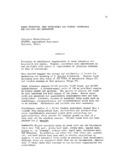Prawn nutrition, feed development and feeding techniques for grow-out and broodstock
Share
Abstract
Knowledge on nutritional requirements of prawn juveniles and broodstock are scanty. However, relatively more information is now available with regard to requirements of juveniles compared to that of broodstock.
Many studies suggest the storage and utilization of lipids for maturation and spawning of P. monodon broodstock. Ovarian lipid increases more than twice at the start of maturation (Stage II) and reaches maximum at full maturity (Stage IV).
Prawn juveniles require 40-45% protein, 5-10% lipid, and 20-25% carbohydrates. A protein-energy ratio of 120 mg prot/Kcal results in better growth and survival. The quality of protein and lipid is very important for both stages of the prawn. Eleven amino acids are essential but quantitative requirements have not been established. Likewise, amounts of essential fatty acids such as arachidonic, docosapentaenoic and eicosahexaenoic acids have yet to be defined. Cholesterol and lecithin are also necessary.
Preliminary results of a 35-day feeding experiment showed that a vitamin free semipurified diet, choline-free and inositol-free diets significantly suppressed growth while niacin-free and pyridoxine-free diets provide for similar growth as that of a diet with all the vitamins present. Mineral needs have not been studied for P. monodon.
Feedstuffs of good nutritive value in prawn grow out and broodstock diets are; fish meal, shrimp head meal, shrimp meal, mussel meat, Acetes sp. or "alamang", soybean meal, squid meal, earthworm meal, and annelids. In addition, cod liver oil, fish liver oil, soybean oil, and beef tallow have been used in varying proportions as sources of some essential fatty acids in practical diet development. Although there are practical diets that can be recommended, improvement of these diets will continue as new nutrient requirements are established.
Suggested Citation
Piedad-Pascual, F. (1989). Prawn nutrition, feed development and feeding techniques for grow-out and broodstock. In R. D. Fortes, L. C. Darvin, & D. L. de Guzman (Eds.), Fish and Crustacean Feeds and Nutrition. Proceedings of the Seminar Workshop on Fish and Crustacean Feeds and Nutrition, University of the Philippines in the Visayas (UPV), Iloilo City, 25-26 February 1985 (pp. 24-29).
Subject
Taxonomic term
Collections
Related items
Showing items related by title, author, creator and subject.
-
Fish nutrition
Carreon-Lagoc, Julia; Southeast Asian Fisheries Development Center, Aquaculture Department (Aquaculture Department, Southeast Asian Fisheries Development Center, 1989) -
Management of feeding aquaculture species
Alava, Veronica R. (Aquaculture Department, Southeast Asian Fisheries Development Center, 2002)This chapter teaches the reader to: differentiate the different feeding strategies in pond culture; learn feeding management methods such as stock sampling and record keeping, calculating daily feed ration, choosing ... -
Evaluation of various protein sources for Penaeus monodon postlarvae
Lim, Chhorn; Suraniranat, Prawit; Platon, Rolando R. (University of the Philippines, Los Baños, 1979)Penaeus monodon postlarvae with an average weight of 15.61 mg each were fed fresh brown mussel meat and artificial diets containing casein, shrimp meal, squid meal and Spirulina as protein sources at a daily rate of 20 per ...





